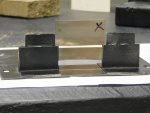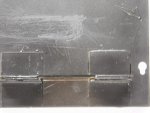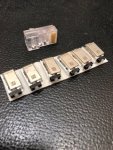Warning: Data dump
I don't see an expander lens build into these little units, just a somewhat weakly collimated output. IMO, for use in a pointer the specified 4 to 8 mRad output divergence needs to be expanded further to get a higher level of collimation to produce a low enough divergence beam. Letting the beam naturally expand before collimation would make a very long pointer, at 8 mRad, the length would need to be like an extra long broom stick at over six and a half feet long to get to about 17 mm diameter before collimation (resulting in ~.47 mRad). That would produce a very low divergence pointer, as most go, but unless you like an uber long pointer, better to use a concave lens in front of it before adding a PCX/plano-convex, or or more ideally, an aspheric collimation lens.
With the 1 mm output beam diameter at the units window, expanding to 20 mm the divergence would be 20 times lower. At that amount of expansion (per the manufacturers 4 to 8 mRad beam divergence specification) the worst case 8 mRad output would then produce a divergence somewhere around .4 mRad, and if 4 mRad output (prior to expansion to 20 mm beam diameter) then close to .2 mRad when expanded that much which is awesome.
I have attached a picture of the PL530 diachi found for the thead as well as some calculations comparing a pointer made with one of these units expanded to 20 mm to a common 5 mm beam diameter 1.4 watt 520 nm much higher divergence pointer which uses a much smaller 6 mm diameter collimation lens. The attachment from laserworld.com shows how much more intensity can be delivered at 8000 meters distance with only 75 mw of output power from the PL530 (exp. to 20 mm) over the far more powerful direct to wavelength laser diode pointer which is running more than 18 times the amount of output power. Keep in mind, the collimation lens is much smaller on the high power pointer which puts it at a further disadvantage, but to sum it up, the far lower output power 75 mw PL530 with a 20 mm collimation lens produces more than 9 times the delivered light intensity at 1500+ meters distant (due to a smaller spot size), compared to the 1400 mw output 5 mm beam diameter 520 nm laser pointer. Note: I would only dare 75 mw if limited duty cycle similar to many DPSS pointers without active cooling at that power, not anywhere close to continuos.
I'm comparing apples with oranges with the different lens diameters, because as for the any laser, changing the beam diameter will change the divergence; larger dia. produces lower divergence, smaller higher. Want lower divergence whether using a direct to wavelength laser diode, DPSS, or one of these OPSL units? Just use a larger diameter collimation lens. However, if using a 6.33 mm diameter aspheric lens which are very common in our pointers, the PL530 will have a
worst case divergence of about 1.6 mRad, the NDG7475 1.4 watt 520 nm laser diode about ~2.6 mRad at identical 5 mm beam diameters (for both). Truth is, with that diameter of a lens, neither of those divergence figures are very impressive, but the PL530 still wins by a large margin, especially if the PL530 happens to have the lower possible output divergence of 4 mRad prior to full collimation. In that case, the divergence will be about .8 mRad which is outstanding with only a 6 mm diameter collimation lens. All of that said, using the same diameter lens, the 75 mw PL530 (at a distance of ~1500 meters or greater,) will be about half the intensity of the 18+ times higher power NDG 7475 1.4 watt laser diode.
Using the same lens diameters at maximum power is the real comparison between the PL530 OPSL and the NDG 7475 520 nm laser diode for delivered brightness of the spot. To sum it up:
When using the same diameter collimation lens, if the PL530 is producing the lowest possible specified raw divergence out of the unit, and is set to produce its maximum possible output power of 120 mw (actively cooled with a TEC), the two pointers using identical collimation lenses will produce very close to the same intensity spot in the far distance, so close you could not tell the difference by eye, just a few percents apart.
Note: At close distances of 100 meters or less, the higher power NDG 7475 begins to win much faster at producing a brighter spot and does so more and more at shorter and shorter distances, it's only at greater distances the far lower divergence much lower power pointer begins to get closer and closer to the brightness of the higher power pointer, becoming closer and closer at several hundred meters and beyond, at a great distance of 50,000 meters they are very close together for spot intensity when producing 120 and 1400 mw output powers (as if we could see it, not). I imagine at some distance, the PL530 would match and begin to over take, but the online calculator I use to get the figures won't show it.
I'm not an optics professional, so I don't know how low of a divergence we could really get with the optics we commonly use for pointers, but I believe I am in the ball park with these figures.
Online divergence calc:
https://www.laserworld.com/en/laserworld-toolbox/divergence-calculator.html#divergence
Got em in the mail yesterday, I want to put these away and not use for awhile, but if someone wants to do a group buy, let's start one, I'm in for a few more so I don't need to touch this pack:











